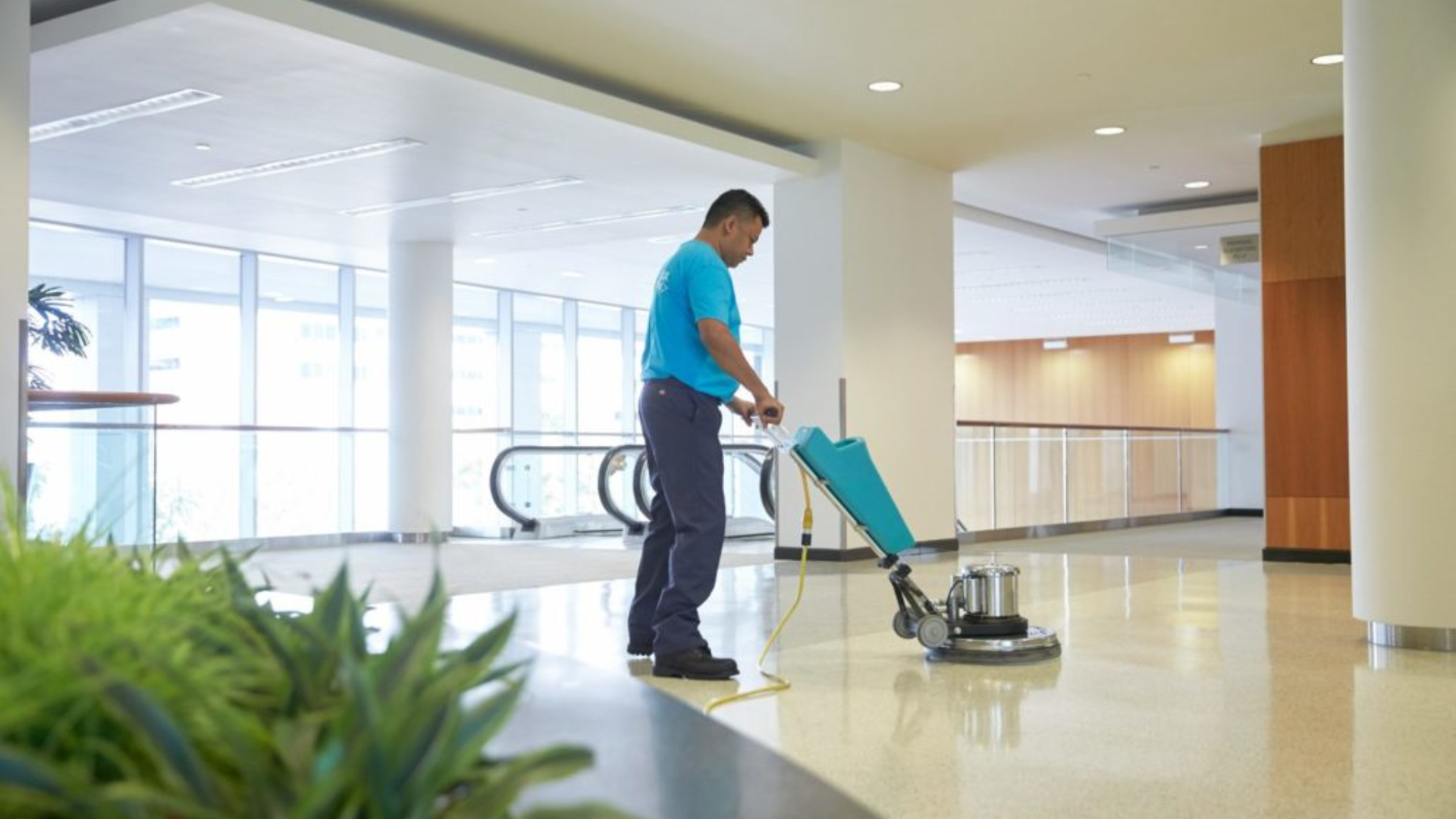Polished concrete floors are a fantastic choice for any home or business, offering a sleek, modern look that’s both durable and low maintenance.
As much as they’re designed to withstand heavy traffic and daily use, it’s still important to care for them properly to maintain that glossy finish.
Over time, dirt, dust, and spills can cause scratches or dull the surface.
I’ve gathered some easy, practical steps you can take to keep your polished concrete floors in top shape, so they continue to shine for years to come.
This guide will help you maintain your floors with minimal effort, ensuring they stay as beautiful and functional as the day they were installed.
How Often Should You Repolish Your Concrete Floors?
The frequency of polishing your concrete floors depends on several factors, including foot traffic, the type of space, and how well the floor has been maintained. Generally, concrete floors should be repolished every 1 to 3 years.
In high-traffic areas like retail stores or commercial spaces, more frequent polishing might be necessary to restore the shine and repair any damage.
For residential spaces, repolishing may only be needed every 2 to 3 years, depending on wear and tear. Regular maintenance, such as dusting and damp mopping, can help extend the time between repolishing.
If you notice your floors looking dull or scratched, it may be time for a repolish.
Understanding Different Methods of Cleaning Concrete
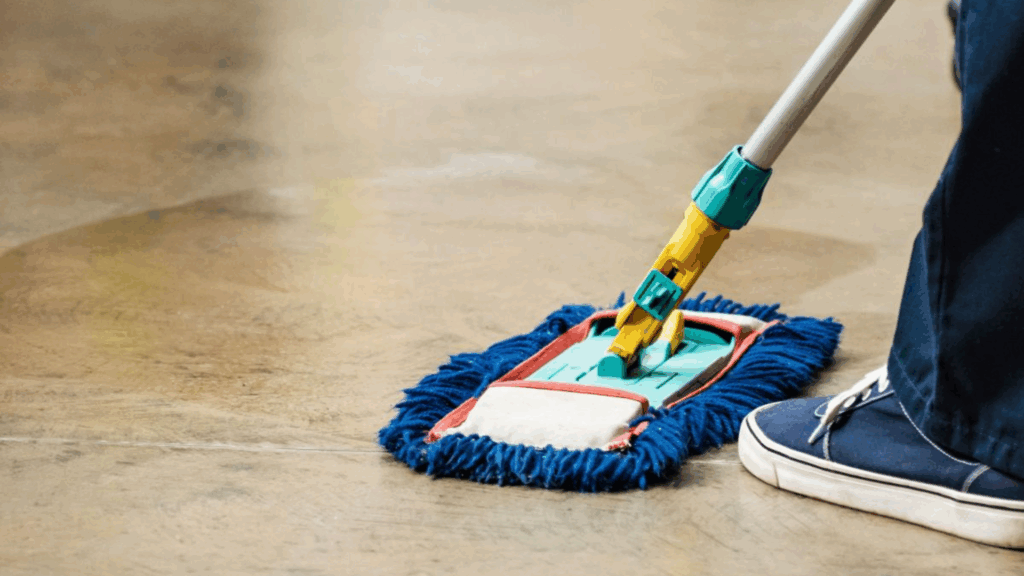
These methods ensure your polished concrete floors stay clean, shiny, and well-protected over time with minimal effort.
1. Daily Dusting: The First Line of Defense
Dust and debris can accumulate quickly, leading to scratches and dullness. Using a microfiber dust mop daily helps in trapping fine particles without scratching the surface.
For larger areas, consider using a vacuum cleaner with a soft brush attachment to remove dirt effectively. Regular dusting prevents grit from acting like sandpaper on your floor’s surface.
2. Damp Mopping with a pH-Neutral Cleaner
Once a week, damp mop your polished concrete floors using a pH-neutral cleaner mixed with warm water. Avoid harsh chemicals like bleach or ammonia, as they can damage the floor’s finish.
Wring out the mop thoroughly to prevent excess water, which can seep into the concrete and cause damage. Mop in sections and allow each area to dry before moving on to the next.
3. Spot Cleaning Stubborn Stains
For persistent stains such as oil, wine, or coffee, create a paste using baking soda and water. Apply the paste to the stained area and let it sit for 10–15 minutes.
Gently scrub with a soft-bristled brush, then rinse with clean water and dry the spot with a microfiber cloth. This method effectively lifts stains without damaging the floor’s surface.
4. Monthly Deep Cleaning
Every month, perform a deep clean to remove embedded dirt and grime. Use a floor scrubber with a soft-bristle brush attachment and a pH-neutral cleaner.
Work in small sections, ensuring the solution doesn’t dry on the surface. After scrubbing, rinse the floor with clean water and allow it to dry completely. This process restores the floor’s shine and removes deeper soil buildup.
5. Polishing for a High-Gloss Finish
To maintain the floor’s glossy appearance, periodic polishing is necessary. Use a high-speed burnisher with a polishing pad designed for concrete floors.
Work in small sections, overlapping each pass to ensure even coverage. Polishing helps in filling micro-scratches and enhances the floor’s reflective quality.
6. Sealing Your Concrete Floor
Applying a sealer protects your polished concrete floor from stains and wear. Choose a penetrating sealer that doesn’t alter the floor’s appearance.
Apply the sealer according to the manufacturer’s instructions, usually every 1–3 years, depending on foot traffic and usage. Sealing enhances the floor’s durability and makes future cleaning easier.
7. Protecting the Surface
Prevent damage by placing mats at entryways to trap dirt and moisture. Use felt pads under furniture legs to avoid scratches.
Avoid dragging heavy objects across the floor; instead, lift them to prevent gouges and abrasions. These protective measures help in maintaining the floor’s integrity and appearance.
8. Avoiding Harmful Cleaning Products
Steer clear of acidic or abrasive cleaners, as they can etch the surface and dull the finish. Products like vinegar, lemon juice, or harsh commercial cleaners should be avoided.
Always opt for cleaners specifically formulated for polished concrete to ensure compatibility and safety.
Step-by-Step on How to Clean Concrete Floors
Follow these straightforward steps to maintain the cleanliness and shine of your concrete floors, keeping them looking like new for longer.
Materials Used
To achieve the best results for maintaining polished concrete floors, several key materials are used throughout the process:
- Cre Guard: A stain protectant that forms a water and oil-repellent seal.
- Cre Clean: A cleaner and degreaser that also hardens and densifies the concrete.
- Cre Shine: A restorer that brings back the shine and polished appearance.
- High-Grit Diamond Pads: These pads help to improve cleaning efficiency and bring out the shine.
- High-Speed Auto Scrubber or Burnisher: A machine that operates at 400 RPM or higher to enhance the cleaning process and restore the floor’s appearance.
Step 1: Protect from Stains with Cre Guard
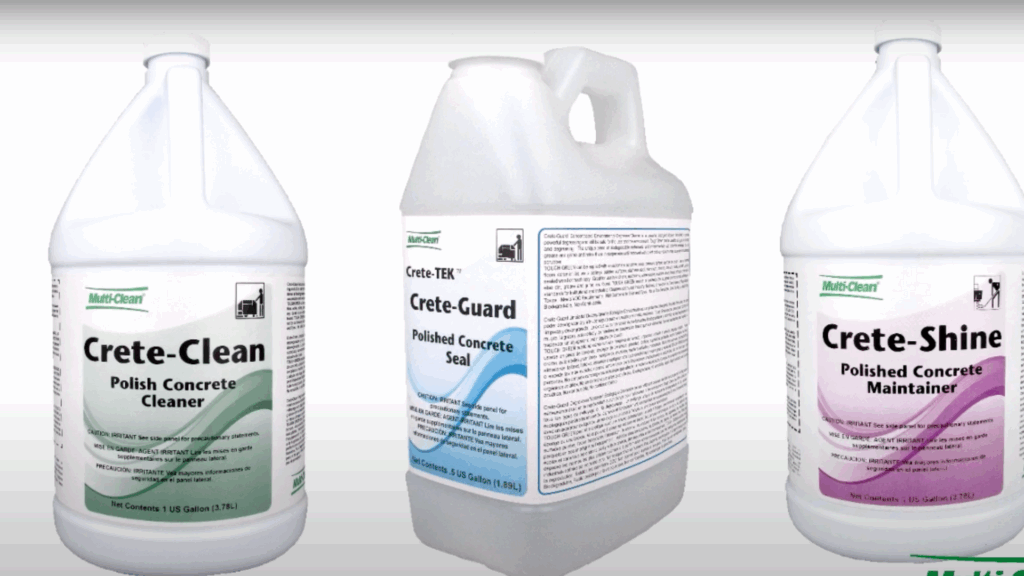
Cre Guard is a stain protectant designed specifically for polished concrete floors. It penetrates the concrete’s pores, creating a water and oil-repellent seal without leaving any film or coating.
This protective layer helps prevent stains, keeping your floors looking clean and fresh for longer periods. It can be applied to newly installed floors or existing polished concrete after a deep cleaning.
By using Cre Guard, you reduce the need for frequent polishing and maintain the floor’s appearance more easily.
Step 2: Clean and Harden with Cre Clean
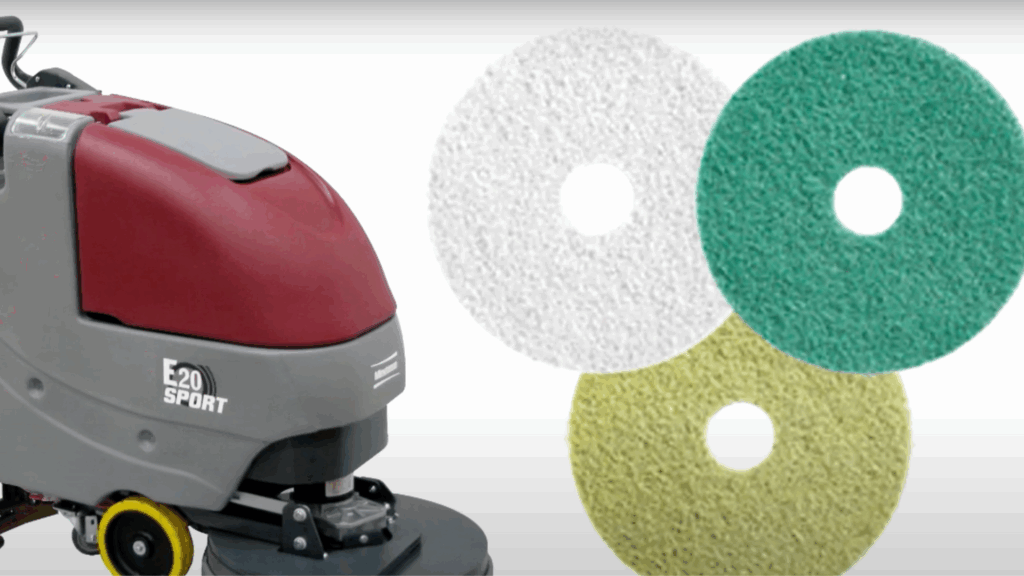
Cre Clean is a highly effective cleaner and degreaser for polished concrete. This product eliminates dirt, grease, and oil buildups while also hardening and densifying the concrete with each use.
Using Cre Clean regularly helps maintain the floor’s durability and appearance. For best results, pair it with a high-grit diamond pad and a high-speed autoscrubber.
This combination ensures a thorough cleaning while enhancing the concrete’s resilience, making it both cleaner and stronger.
Step 3: Restore the Shine with Cre Shine
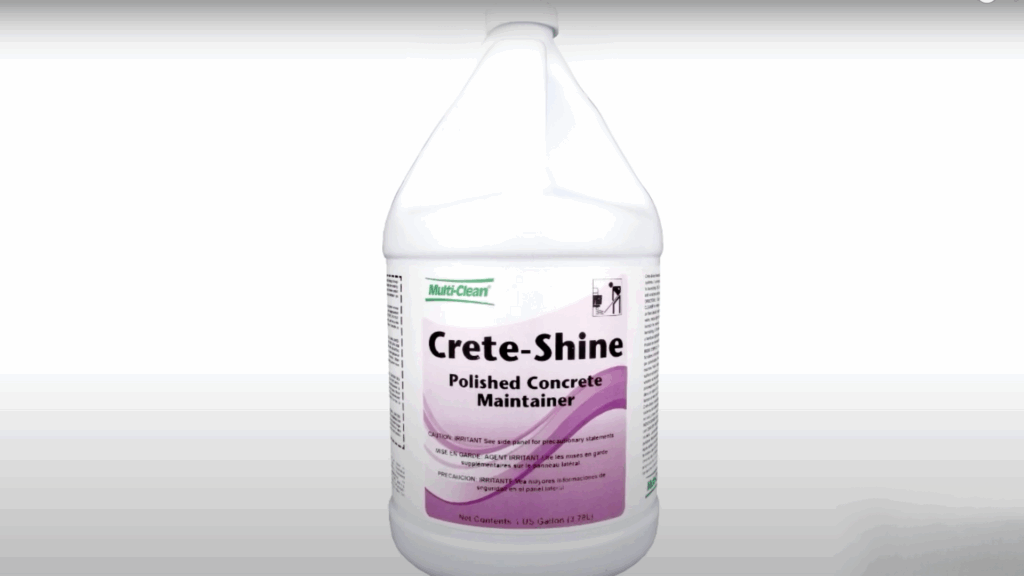
To bring back the shine and restore the polished look of your floors, Cre Shine is the ideal product.
This floor restorer can be applied in three different ways: by spraying and burnishing with a high-speed burnisher, mopping it on and burnishing afterward, or running it through a high-speed autoscrubber.
Whichever method you choose, pairing Cre Shine with a high-grit diamond pad ensures the best shine. This step helps rejuvenate older floors, restoring their glossy, polished finish.
Step 4: Regular Maintenance for Long-Term Care
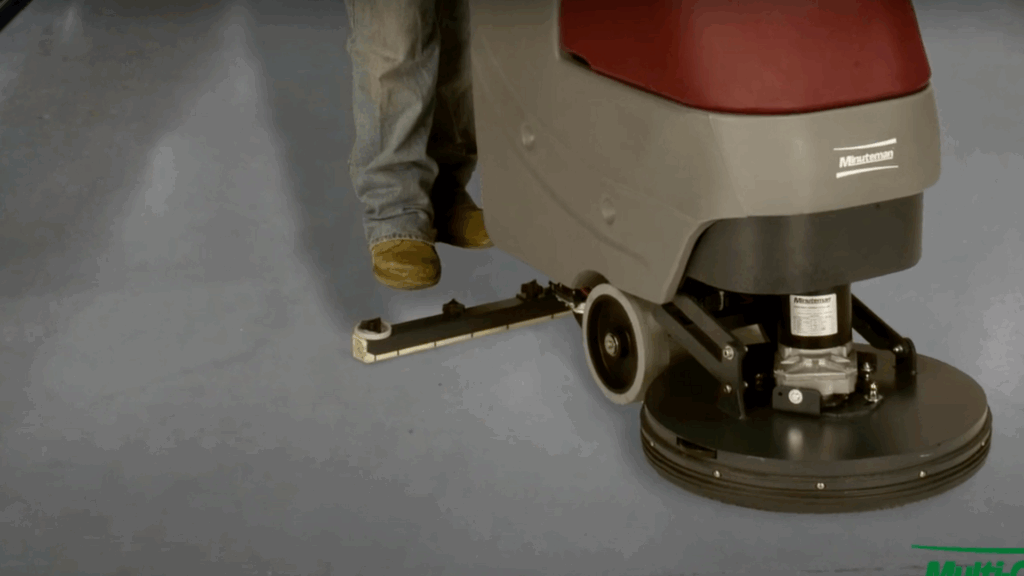
Maintaining polished concrete floors requires consistent care. After applying Cre Guard, Cre Clean, and Cre Shine, it’s important to establish a regular maintenance routine.
Dust and debris can accumulate on the floor, which may cause scratches if not cleaned regularly.
Use a microfiber mop daily for dusting, and damp mop the floors weekly with a pH-neutral cleaner.
Monthly, consider performing a deep clean using a high-speed scrubber for a better shine.
Following this routine helps extend the life of your polished concrete floors and keeps them looking their best.
For a visual guide, refer to this video by @MultiCleanProducton YouTube.
Why Professional Help May Be Necessary for Repolishing?
While regular cleaning and maintenance can keep your polished concrete floors in great condition, repolishing is a more complex task that often requires professional expertise.
Over time, the floor’s finish may start to lose its shine due to heavy foot traffic, spills, or wear and tear.
Repolishing involves specialized equipment and techniques, such as diamond grinding and polishing, that help restore the floor’s glossy appearance and remove deeper scratches or imperfections.
Professionals have the experience and tools necessary to achieve a smooth, even finish without damaging the surface.
If your floor is significantly worn or you want to achieve a high-quality, long-lasting result, professional help is the best option.
Tips for Extending the Life of Your Polished Concrete Floors
Taking the right precautions and regular maintenance steps can significantly prolong the beauty and durability of your polished concrete floors.
- Regularly dust and sweep to remove debris and prevent scratches.
- Damp mop with a pH-neutral cleaner to avoid damaging the finish.
- Avoid harsh chemicals like bleach, ammonia, or acidic cleaners that can dull the surface.
- Place doormats at entrances to trap dirt and moisture before it reaches the floor.
- Use furniture pads to protect floors from scratches caused by heavy furniture.
- Avoid dragging heavy items across the floor to prevent gouging or abrasions.
- Apply a protective sealer every 1-3 years to help prevent staining and maintain shine.
- Use a high-speed burnisher to restore gloss during deep cleaning sessions.
- Clean up spills immediately to prevent staining or moisture damage.
- Re-polish the floor periodically to restore shine and keep the surface looking new.
Conclusion
Polished concrete floors are durable and beautiful but require regular care to maintain their shine.
Simple practices like daily dusting, mopping with pH-neutral cleaners, and applying a protective sealer will keep your floors looking great.
Clean spills quickly, use appropriate cleaning products, and avoid harsh chemicals to protect the finish.
Establishing a consistent cleaning routine with the right tools, like a high-speed burnisher, can restore shine.
With these steps, your polished concrete floors will remain a stunning feature for years. For personalized advice on floor maintenance, feel free to reach out.

